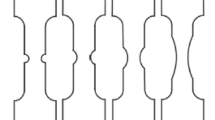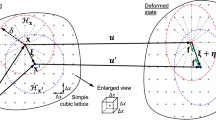Abstract
The essential work of fracture method is widely used for the determination of fracture toughness of ductile metals and polymers under plane stress conditions. Nevertheless, this method has numerous prerequisites, which are easy to fulfill in metals, but are less certain in polymers. The aim of this study was, therefore, to present a simple, empiric “displacement-criterion” that helps the determination of valid ligament lengths for polymers—one of the biggest sources of error of this theory. This criterion not only facilitates the definition of a lower bound, but also helps the description of an upper ligament limit. Its other advantage is, that combined with a stress criterion, it helps the data validation not only until crack initiation, but also over the entire deformation process.




Similar content being viewed by others
References
Bárány T, Czigány T, Karger-Kocsis J (2010) Prog Polym Sci 35(10):1257
Cotterell B, Pardoen T, Atkins AG (2005) Eng Fract Mech 72(6):827
Pegoretti A, Castellani L, Franchini L, Mariani P, Penati A (2009) Eng Fract Mech 76(18):2788
Hill R (1952) J Mech Phys Solids 1(1):19
Clutton E (2001) In: Moore DR, Pavan A, Williams JG (eds) Fracture mechanics testing methods for polymers adhesives and composites, vol 28. Elsevier, Amsterdam, p 177
Cotterell B, Reddel JK (1977) Int J Fract 13(3):267. doi:https://doi.org/10.1007/bf00040143
Marchal Y, Walhin J-F, Delannay F (1997) Int J Fract 87(2):189
Wu J, Mai Y-W (1996) Polym Eng Sci 36(18):2275. doi:https://doi.org/10.1002/pen.10626
Arkhireyeva A, Hashemi S (2001) Plast Rubber Compos 30(7):337
Duan K, Hu X, Stachowiak G (2006) Compos Sci Technol 66(16):3172
Martinez AB, Gamez-Perez J, Sanchez-Soto M, Velasco JI, Santana OO, Ll Maspoch M (2009) Eng Fail Anal 16(8):2604
Gamez-Perez J (2007) Structure-properties relationships of polypropylene and ethylene-propylene block copolymers plates and thin sheets obtained by different transformation processes. PhD thesis, UPC-BarcelonaTech, Barcelona
Gamez-Perez J, Velazquez-Infante JC, Franco-Urquiza E, Pages P, Carrasco F, Santana OO, Maspoch ML (2011) Express Polym Lett 5(1):82
Oláh L, Tuba F (2010) Macromol Symp 296(1):371. doi:https://doi.org/10.1002/masy.201051051
Williams JG, Rink M (2007) Eng Fract Mech 74(7):1009
Acknowledgements
This study is connected to the scientific program of the “Development of quality-oriented and harmonized R+D+I strategy and functional model at BME” project. This project is supported by the New Széchenyi Plan (Project ID: TÁMOP-4.2.1/B-09/1/KMR-2010-0002).
Author information
Authors and Affiliations
Corresponding author
Rights and permissions
About this article
Cite this article
Tuba, F., Oláh, L. & Nagy, P. Essential work of fracture study of polymers: a novel criterion for the validation of tested ligament range. J Mater Sci 46, 7901–7904 (2011). https://doi.org/10.1007/s10853-011-5778-z
Received:
Accepted:
Published:
Issue Date:
DOI: https://doi.org/10.1007/s10853-011-5778-z




